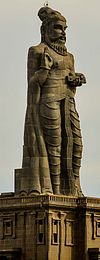| Tirutthanigai Saravanaperumal Aiyar | |
|---|---|
| Born | Saravanaperumal 1799 |
| Nationality | Indian |
| Occupation | Tamil scholar |
| Known for | Commentary on the Tirukkural and Tiruvalluva Maalai |
| Father | Thanigai Kanthappaiyar |
Tirutthanigai Saravanaperumal Aiyar (1799–19th century CE) was a Tamil scholar, best known for his commentary on the Tirukkural and other Tamil classics.
Biography
Saravanaperumal Aiyar was the son of great Tamil scholar named Thanigai Kanthappaiyar. The family hailed from Thiruthani and hence the name "Thanigai" became part of the family's names. Kanthappaiyar moved to Purasawalkam in Chennai. It is said that Scholar Kachiyappa Sivachariyar wrote Vinayakapuranam in the Purasawalkam house of Kanthappaiyar. Unlike the title "Aiyar" in their names suggest, the Kanthappaiyar family were not Brahmins but Veera Saivites. Saravanaperumal was the contemporary of Ramalinga Vallalar.
Saravanaperumal's elder twin brother Vishakaperumal Aiyar too was a renowned Tamil scholar who worked in the Tamil department of the Presidency College in Chennai. His contributions include a poem written as an introduction to his brother's work. He had a collection of many rare books which were later used by U. V. Swaminatha Iyer.
Works
Saravanaperumal's greatest work was his detailed commentary on the Tirukkural. This was the first modern commentary to appear in print. He published the commentary in 1830 as an adaptation of Parimelalhagar’s commentary, with word-to-word meaning, brief explanation, and special explanatory text. However, the 1830 edition is lost and the oldest available edition was a copy published in 1847. The work came out in several editions (at least eight) until 1928 and became one of the most accepted commentary among academic scholars. Many modern commentaries are based on the work of Saravanaperumal Aiyar.
Saravanaperumal also wrote the first commentary to the Tiruvalluva Maalai.
See also
Notes
- ^ Kolappan, B. (3 October 2019). "1830 Tirukkural commentary to be relaunched". The Hindu. Chennai: Kasturi & Sons. p. 4. Retrieved 13 October 2019.
- Kovaimani and Nagarajan, 2013, pp. 116–117.
- ^ Kovaimani and Nagarajan, 2013, p. 117.
- Desikar, 1969, p. 118.
References
- Desikar, S. Dhandapani (1969). திருக்குறள் அழகும் அமைப்பும் (in Tamil). Chennai: Tamil Valarcchi Iyakkam.
- M. G. Kovaimani and P. V. Nagarajan (2013). திருக்குறள் ஆய்வுமாலை (in Tamil) (1 ed.). Tanjavur: Tamil University. ISBN 978-81-7090-435-9.
| Tamil language | |||||||||||||
|---|---|---|---|---|---|---|---|---|---|---|---|---|---|
| History | |||||||||||||
| Dialects |
| ||||||||||||
| Global organizations | |||||||||||||
| Literature |
| ||||||||||||
| Tamil and other languages | |||||||||||||
| Scripts | |||||||||||||
| Lexis and grammar | |||||||||||||
| Phonology | |||||||||||||
| Transliteration | |||||||||||||
| Events | |||||||||||||
